|
|
ohforfsake

  
     
Promising
Legendary Hero
Initiate
|
 posted October 29, 2009 09:05 AM
posted October 29, 2009 09:05 AM |
|
|
Quote:
Ohforfsake got it right. Nice job 
Cool, thank you. 
I used to play the game myself, when I was around 9-10 years, I had no idea how to plan for a win though, so I'd usually always only win if the opponent made a mistake (often I'd use in a 5 hour game, up to 1 hour on thinking a moveset through, to realise it was going no where and get in trouble with the clock  ). ).
However I knew a lot of openings and a lot of end game material, my proudest thing was that I could mate with a bishop and a horse, though I've lost all skill (or maybe it was never skill, more patience) now, as it's many years ago. 
____________
Living time backwards
|
|
antipaladin

  
     
Promising
Legendary Hero
of Ooohs and Aaahs
|
 posted October 29, 2009 01:10 PM
posted October 29, 2009 01:10 PM |
|
|
i like to play for it challange,and kind've meeting new people,i was thought by the age of 10 by my ametour father , and by 12-14 i played in several ametour contests. its fun and intimate at the same time,you get to try ot read opponent mind for hes moves forword,and anticipate moves. taking advantge is wrong but is high sufficent,i like to toutor less expearnced as well,like saying,no you cant go there,its defended ill take that figoure or so,i'm nothing but ametour,but i really like cousing forks,esspacily Tower/queen rocks. also i had an argument with afrinde about something , do i have to call when i preform Garde` on you? means when i endenger your queen?
edit: i forgot to mention i'd really like to play you two,esspacily ohforsake,seems to be my kind've of guy!
btw keldorn you are 17 are you not? your seem quite an expert!
____________
types in obscure english
|
|
keldorn

  
  
Promising
Known Hero
that casts green flames
|
 posted October 29, 2009 01:37 PM
posted October 29, 2009 01:37 PM |
|
|
Well, I'm actually 18, I just haven't changed my profile yet (I'm too lazy and always forgetting it too ) )
And I am by no means an expert, only a chess player who has learned some tactics and tricks in chess. This is what I'm showing you in this thread. On chess.com, I'm rated around 1500, which is considered to be a solid club player's, or at most a tournamenter's rating. Chess mastery begins at 2000-2200. I know a lot of openings, but far less than masters, and far less deeply. But this level is enough to beat all 36 of my classmates  My best win though was against a 1695-rated guy. My best win though was against a 1695-rated guy.
____________
|
|
ohforfsake

  
     
Promising
Legendary Hero
Initiate
|
 posted October 29, 2009 03:03 PM
posted October 29, 2009 03:03 PM |
|
|
Quote:
edit: i forgot to mention i'd really like to play you two,esspacily ohforsake,seems to be my kind've of guy!
Well thank you. 
I don't however enjoy playing the game very much, it's not very entertaining for me, but if I get in the mood I'll send you a message and then we could play on chess.com sometime.
Also, one thing I really enjoyed when I was younger was to find limits of the computer when you played against it, because the computer would often have been given a rating, which should correspond to the strength of a real player (we'd a 2000 rating computer program back then), but in reality, all these programs could do, was to see a limited number of steps forward, and that meant if you could make a plan that would require more steps than what the computer could see, it was very likely you could trick it.
As an example, on chess.com I think it is, there's a computer that on hard diff can see about 5 moves forward, getting your rooks and quenn over to the computers king side, together with a pawn preassure and a single horse / bishop will often end up in victory if you choose to sacrifice, where a good player would be able to prevent it the computer suddenly goes from "I'm ahead of you and going to win" to "You can mate me in x moves" or something like that.
Also you don't have to call when you threat a quenn (not a king either, some believe you've to say check, but it's not obligatory), at least that's what I was taught back then. 
(But if your opponent doesn't realise he's in a check and starts moving something else, you'll of course make him aware of he is in check at that point).
____________
Living time backwards
|
|
Keldorn

  
  
Promising
Known Hero
that casts green flames
|
 posted October 29, 2009 06:43 PM
posted October 29, 2009 06:43 PM |
|
|
OK, so I got 5 solutions so far, 4 of which was correct. One (sent by Antipaladin) was almost as good, but unfortunately it falls for a mating trap. Knight d4-c2?? is also a fork, but white can just ignore his Rook and play Qe3-h6!! with mate inevitable next move (Qh6-g7#)
Thus the correct answer is Qa5xd2!! which wins a knight, because if white takes back (Qe3xd2) black can then play Nd4-f3+ winning back the white Queen with a fork, leaving black a Knight up. Note that black's first move (Qa5xd2!!) prevents white's mate threat as well.
You can watch the entire game here: http://www.chess.com/echess/game.html?id=29298439
I'll post another puzzle soon. Cheers!
____________
|
|
antipaladin

  
     
Promising
Legendary Hero
of Ooohs and Aaahs
|
 posted October 29, 2009 09:15 PM
posted October 29, 2009 09:15 PM |
|
|
no wonder i sucked,i missunderstood your post. when you said white made a mistake i thought it was a mistake that had to be taken advantge of.  oh well,so much for ammetour,well i start chess.com,to see how much i'd rank, oh well,so much for ammetour,well i start chess.com,to see how much i'd rank,
edit: if wq go e3-h6 i can counter it with d5-h5 rock?
____________
types in obscure english
|
|
eCoRiS

  
    
Promising
Supreme Hero
|
 posted October 29, 2009 10:28 PM
posted October 29, 2009 10:28 PM |
|
|
Uh, no. His next move would then be Qg7++.
____________
|
|
keldorn

  
  
Promising
Known Hero
that casts green flames
|
 posted October 30, 2009 08:56 AM
posted October 30, 2009 08:56 AM |
|
|
OK this one is just a little harder, but the tactical weapon you need to use is the same. In the last puzzle, we used a fork, attraction(to force the white Queen to d2) and removing the defender(Qxd2!! removes the knight's defense from f3). This time you need to use one of the previous tricks, and a new one, which I'll introduce later.
Here it's white to move and win material. The solution is 3 pairs of moves long again.
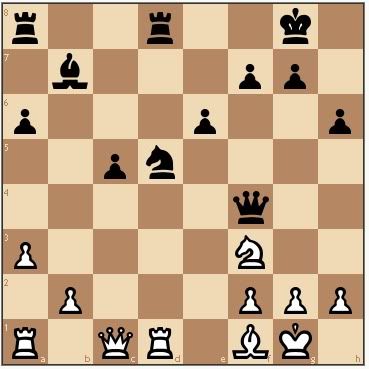
Use HCM please! Good luck.
____________
|
|
keldorn

  
  
Promising
Known Hero
that casts green flames
|
 posted October 30, 2009 06:20 PM
posted October 30, 2009 06:20 PM |
|
|
And our solution is Rd1xd5! and white's Queen loses her defender. Thus, black can't retake our rook. Instead he tries to trade Queens with Qf4xc1. But this doesn't scare us, we can simply play Rd5xd8+ avoiding a Rook loss by trading. White must end the check with the only logical answer Ra8xd8 and we win back the Queen Ra1xc1. The dust has cleared, white emerges a knight ahead.
Well done everyone: I got 4 messages and all were correct  . .
I promised to introduce a new trick after the puzzle. It's called Zwischenzug or In-between move.
On move 2 in this puzzle, our logical response would have been to take back the Queen immediately. But that would have lost an exchange (Rook for Knight or Bishop). So we used the Zwischenzug tactic (we made a forceful move before playing the logical continuation). This is a powerful trick 
So I hope everyone has tuned their brain to chess again, so we can deal with a bit complicated puzzles. But before we do so, I'll write a basic chess dictionary based on what we've learned so far. It's going to be a review or something like that 
I need to prepare for it a little. In the meantime, feel free to post a puzzle of your own.
____________
|
|
antipaladin

  
     
Promising
Legendary Hero
of Ooohs and Aaahs
|
 posted October 31, 2009 02:14 AM
posted October 31, 2009 02:14 AM |
|
|
i find those puzzles not really good,no offence,but how can you excally predict black or white moves,he can move alot moves,that arent 100% officent,its up to the player really. more intersting training or officent imo,is learining to mate with rock and bishop or horse alone,while no body else,and with limited amount of moves. that how i was thought.
____________
types in obscure english
|
|
TheDeath

   
      
Responsible
Undefeatable Hero
with serious business
|
 posted October 31, 2009 03:15 AM
posted October 31, 2009 03:15 AM |
|
|
Usually there's only one good move your opponent can do, all other moves are absolutely terrible in those puzzles.
____________
The above post is subject to SIRIOUSness.
No jokes were harmed during the making of this signature.
|
|
keldorn

  
  
Promising
Known Hero
that casts green flames
|
 posted October 31, 2009 06:23 PM
posted October 31, 2009 06:23 PM |
 bonus applied by angelito on 02 Nov 2009. bonus applied by angelito on 02 Nov 2009. |
Edited by keldorn at 20:41, 31 Oct 2009.
|
I'm back with a chess review about what we've learned so far.
How the pieces move:
The pawn: One or 2 squares forward on their first move, later only one. Captures diagonally forward Special abilities: en passant capture, promotion (value=1 point)
The Knight: It moves in the form of the letter L. Can jump over the pawn chain or any other obstacle. (value=3)
The Bishop: Travels along diagonals, touching only dark or light squares. (value=3)
The Rook: Travels vertically (along files) and horizontally (along ranks) (value=5)
The Queen: Moves like the Bishop and the Rook, so along ranks, files and diagonals. (value=9)
The King: Moves to any adjacent square, unless it is attacked. Special abilities: Can't be taken, castling

Basic tactical weapons
Pin: When a piece attacks an enemy piece, and there is a more valuable one in the line of the attack, but behind the attacked one, it can't move otherwise the more valuable one will be taken. We know the relative pin (when the pinned piece can move, but suffers from losing heavy material) and absolute pin (when the piece is pinned to its king: every move with it is illegal)
Skewer: Inverse of pin: a valuable piece is attacked and when it moves, we can capture a less valuable one.
Fork: Also known as double attack. One piece attacks more than one enemy pieces with one move.
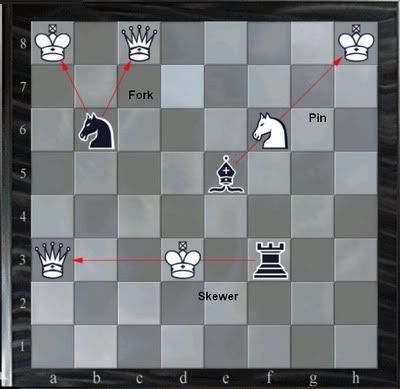
Discovered attack: When a friendly piece hinders another piece, and the front piece moves away, the piece behind it will be freed up, unleashing an attack without having to move.
Interference: If 2 pieces guard each other, we can interpose our own piece in the line of defence, leaving both defenders, now undefended.
X-Ray attack: Almost the same as Interference, but this time we have 2 attackers lined up with each other, so the interposed piece can't safely take either of them.

Zugzwang: Obligation to move. In other words, a position where you'd rather pass, but you must move, thus hurting your position. (see the picture below: The player who moves, loses because he has to abandon the defense of his pawn)
Removing the defender: You can chase away (also known as decoy) or capture the defender of a piece, so after the exchange, you can safely take the former-protected piece.
Clearance: Freeing up a square for tactical attacks. This is usually done by using forcing moves, so that your opponent won't have time to react to your new threat: the cleared square.
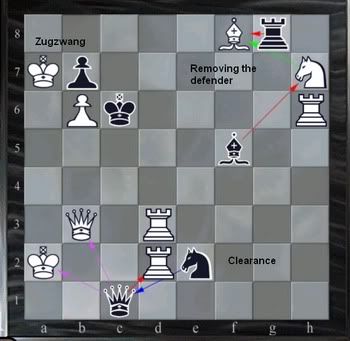
Distraction: Forcing the defender away from the defended piece (same as decoy)
Trapped piece: When a piece has no safe squares to go, because all of them is guarded. Checkmate for example, is when you trap the king. On the position below, black played Bishop takes pawn on h7, which was a mistake. White traps the Bishop with g7-g6, and devours it with his king in 2 moves. (Kf8-g7, Kg7xh7)
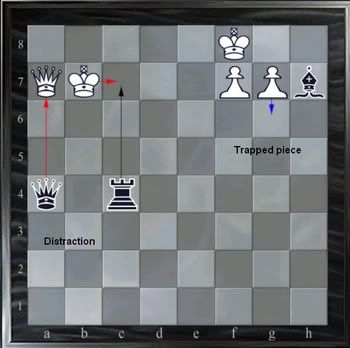
Attraction:The opposite of distraction ( ), when you force a piece to a square where you want it to be. (The picture above illustartes the same setup on 2 boards, I was just too lazy making another picture ), when you force a piece to a square where you want it to be. (The picture above illustartes the same setup on 2 boards, I was just too lazy making another picture  ) )
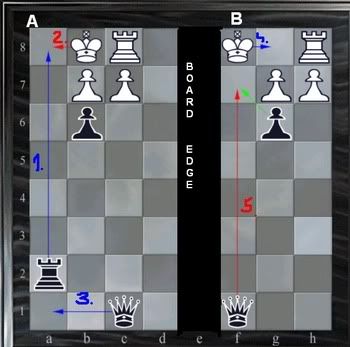
Zwischenzug: In-between move. We play a very forcing move before the logical continuation. (for example: like in the first of the 2 puzzles this week. Black takes Queen, we give check and THEN retake the Queen)
Sacrifice: Giving up material for positional advantage (for a forced mate for example) There are positional, mating, material-winning sacrifices.
Chess dictionary in alphabetical order
50-move rule: If the two players don't capture a piece or push a pawn for 50 pairs of moves, the game ends in a draw.
Advanced pawn: A pawn that has been pushed deep into the enemy's position
Analysis: After the game, the two players sit down again and tell each other their ideas about every move, revealing the mistakes and the best moves.
Attack: Concentrating our forces to the enemy's king camp. When we have more attacking pieces than enemy defenders, we should consider breakthrough- or destructive sacrifices to get to the king and mate.
Back rank: 1st rank for White, 8th rank for Black
Blockade: Placing a piece in front of a pawn to make it immobile.
Blunder: A serious mistake, usually leading to losing the game. (marked with ??, e.g. Re1-f1??)
Breakthrough: Destroying the pawn chain to make a passed pawn (see at 'P')
Castling: The king moves two squares towards the Rook, and the Rook jumps over it. It's goal is king safety and Rook development. You can't castle if: the king or the rook has moved (even if returned), the king is in check, the king arrives into check, or the king moves through check.
Center: The squares e4,d4,e5,d5
Check: The king is under attack
Checkmate: The king is under attack and it can't be saved on the next move. The game is lost.
Combination: Usage of tactical tricks, more than one, and in more than one move.
Compensation: This is what we sacrifice for: we surrender material to get other type of advantage.
Counterplay: When our opponent tries to refute our plans, anticipate our ideas and create an attack himself.
Development: Placement of pieces in the opening.
Diagonal: lines that run through the chessboard, southwest, southeast, northwest and northeast (couldn't find a better way to explain  ) )
Doubled pawns: 2 or more pawns being on the same file.
Draw: Tied game. Score is 1/2-1/2 for both sides.
Endgame: The game phase after trading Queens. In this stage, tactical possibilities are reduced due to the lack of Queens.
Fianchetto: Developing our Bishop on the long diagonal in the opening (for example white plays 1.g2-g3, 2.Bf1-g2)
FIDE: (French: Federation International Des Échec) International Chess Federation. Pronounced: Fee-day
File: Vertical lines on the chessboard (e.g. g-file)
Flank: "Non-central"
Forcing move: A move that leaves our opponent with very few options. Usually a check is like this.
Gambit: Sacrifice of a pawn or two in the opening to get speedy development or other positional advantages.
Grandmaster: FIDE professionals with at least 3 tournament wins and over 2400 rating.
Hanging piece: Undefended piece, but not poisoned so it's free to take. Normally results from an oversight.
Heavy pieces: Rooks and Queens
Initiative: The player who has the initiative is usually the attacker, creating threats which his opponent must defend, making him unable to get counterplay.
Isolated pawn: When a pawn doesn't have allied pawns which can protect him (= there are no pawns on the 2 adjacent files)
Material advantage: The value of the captured pieces are higher
than our opponent's.
Middlegame: After the 8-10-moves-long opening, begins the middlegame, lasting for the trade of Queens.
Minor piece: Bishops and Knights.
Mobility: The quantity of the squares a piece can go to.
Open/closed position: If the pawns blockade each other, it's a closed position where Knights are better. If not, it's an open game, where Bishops usually dominate.
Opening: The initial moves of the game, usually players know it by heart. They just have to decide which variation they want to play.
Opposition: An important trick if the players have only pawns on the board. Opposition is when the two kings are separated by an odd number of squares. Thus, the player on the move must break the opposition, steps aside, and the other player's king penetrates.
Outpost: A square that can't be attacked by enemy pawns, and is defended by allied pawns.
Overloading: When a piece has too much things to do. Here we can use the tactic of decoy or removing the defender.
Oversight: Making a mistake due to the lack of attention.
Passed pawn: When a pawn can't be stopped by enemy pawns (= there are no enemy pawns on that file, and on the adjacent fiels)
Pawn island: A compact chain of pawns. If there's a break in the chain, the player has 2 islands. If there are 2 breaks, that means 3 islands. The more islands the weaker the position.
Pawn structure: The placement of the pawns. Includes doubled-, isolated-, passed pawns.
Perpetual check: If one side keeps on checking the other one. No progress can be made, so this is a drawing resource in case we are in a losing position.
Plan: The intentions of a player.
Poisoned pawn: An unguarded pawn, which can't be taken safely for tactical reasons. In other words: bait.
Positional advantage: If a player has better piece development or has the initiative etc.
Promotion: If a pawn reaches the opponent's back rank, it can be changed to any other piece except a King.
Quiet move: A move which comes with a hidden threat, usually not direct threat.
Rank: Horizontal lines on the chessboard (e.g. 3rd rank)
Rating: a number which indicaltes play strength. A master needs 2000, a grandmaster needs 2400. (for comparison: I have around 1500)
Resignation: Giving up the game. This is done by tipping the king.
Simplification: Trading pieces to make the position clear.
Smother: Leaving the enemy king with no squares to go.
Spacial advantage: If our pawns or pieces are in our opponent's territorry, leaving him with little mobility.
Stalemate: Drawing resource in the endgame. When a plyer can make no legal moves, but his king is not in check. 1/2-1/2
Strategy: Long-term plans, resulting in positional gains.
Tactic: Short-term plans, resulting in material advantage or mate.
Tempo: Time gaining. For example a checking move can often gain tempo. Or another example: when our opponents develop his Queen eary (which is a bad idea), we can develop with tempo: place our own pieces to attack the Queen.
Tension: When a piece is in take (can be captured) or pinned, it's under tension.
Threefold repetition: When the exact same position is repeated 3 times in the same game, it's declared a draw.
Trade: Exchanging pieces of the same value.
Underpromotion: Promoting our passed pawn to a Rook, Knight or Bishop.

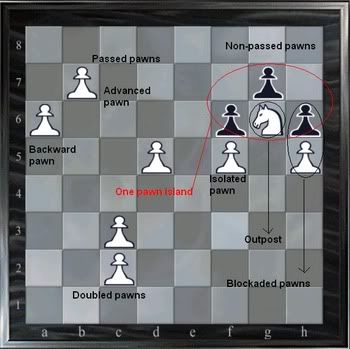
Notations in chess
We will deal with the long algebraic notation, which names the moving piece and the starting and ending squares.
Q is for Queen
R is for Rook
B is for Bishop
K is for King
N is for Knight (as K is already taken)
Pawns don't have letters. We don't put a letter in front of the coordinates.
Examples: Rd2-d3; Qb3-d5; a2-a3
x means takes. Rd1xf1
+ means check, # means mate. Bd2-e3# or Nd7xb8+
Promotion is marked with an equotation mark (=) e7-e8=Q+ or b2xc1=R
Castle short (kingside) is O-O, long (Queenside) is O-O-O
En passant capture is marked as follows:
1. g7-g5 f5xg6ep (not g5ep!!)
Basic checkmates
I) MATE WITH KING AND 2 HEAVY PIECES
We call this method stair-stepping. We cut the escape route with one of the peces, and give check with the other.
II) MATE WITH KING AND QUEEN
You can skip this if you want, because Queens can be used as Rooks as well, so if you learn how to mate with Rook, you know how to mate with Queen, too.
Our goal is to close the king in a box, get closer with our own king, and finally mate him with either the classical "Kiss of Death" mate, or the Rook's mate. Simply move your Queen one rank up if the King moves up. On the last rank, take the opposition with your King, and give the Kiss of Death.
III) MATE WITH A ROOK ONLY
You need to force your opponent's king into an opposition (because in this case your king is shielding the in-between rank so the king can only go upwards) and give check with the Rook (which covers the current rank of the enemy king). Continue this until mate. NOTE: You may have to make a waiting move during the process to force the opposition. Do this with your Rook, without changing rank with it.
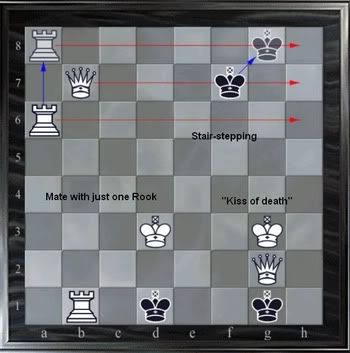
IV) MATE WITH TWO BISHOPS
This is the most difficult of the 4 basic mates. You need to form a so-called 'fence' with your bishops. (see diagram below). Come closer with the king, and tighten the fence. Once you get to the last rank, you need to force the king to the corner which is closer to the bishop pair. To do this, your king needs to occupy the 6th rank, and on the same side of the bishops. You can now break the fence, using your bishops to prevent the enemy king form escaping to the other corner. Finally, you can mate him. Check out the photoes:
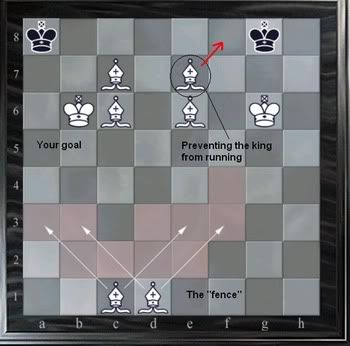
And I think that's all. Phew, took me a few hour, but it was worthy  . Enjoy. NOTE: Mating patterns are demonstrated very briefly. If you want me to show it with more details, tell me. Also, feel free to ask if something's not clear. . Enjoy. NOTE: Mating patterns are demonstrated very briefly. If you want me to show it with more details, tell me. Also, feel free to ask if something's not clear.
____________
|
|
antipaladin

  
     
Promising
Legendary Hero
of Ooohs and Aaahs
|
 posted November 01, 2009 12:30 PM
posted November 01, 2009 12:30 PM |
|
|
qp worthy imo!
____________
types in obscure english
|
|
keldorn

  
  
Promising
Known Hero
that casts green flames
|
 posted November 02, 2009 07:44 PM
posted November 02, 2009 07:44 PM |
|
|
Now it's time to use our chess database. Here's a puzzle. White moves and mates in 5. Tags: attraction, sacrifice, double check, ??? (If I gave this the puzzle would become too easy  ) Good luck ) Good luck
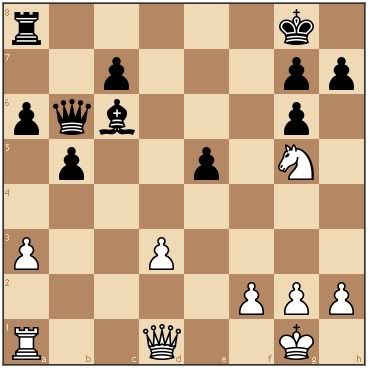
____________
|
|
ohforfsake

  
     
Promising
Legendary Hero
Initiate
|
 posted November 02, 2009 08:29 PM
posted November 02, 2009 08:29 PM |
|
|
I also think it's worthy of a quality point.
____________
Living time backwards
|
|
keldorn

  
  
Promising
Known Hero
that casts green flames
|
 posted November 03, 2009 05:35 PM
posted November 03, 2009 05:35 PM |
|
|
I'm glad to see you're content with my chess summary 
Anyway, the last tag for the problem was smother.
The solution runs: 1.Qd1-b3+! Kg8-f8 (NOT Kg8-e8?? 2.Qb3-f7#, or Bc6-d5? 2. Qb3xd5+ Kg8-h8 3.Qd5xa8+ with mate next move)
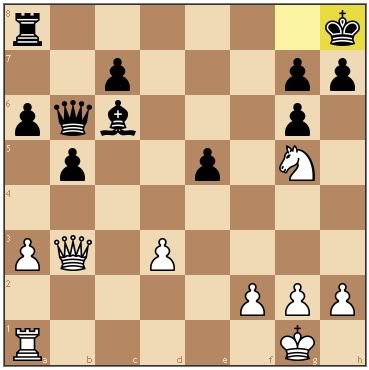
2.Ng5-f7+! Kh8-g8 forced.
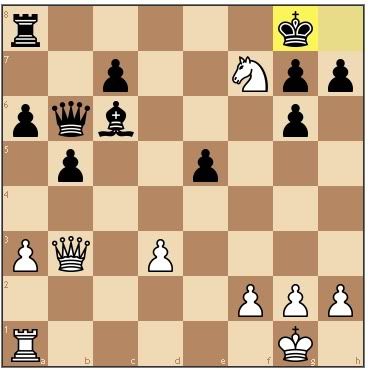
3.Nf7-h6+ (discovered attack  double check) Kg8-h8 (again if Kg8-f8?? Qb3-f7#) double check) Kg8-h8 (again if Kg8-f8?? Qb3-f7#)
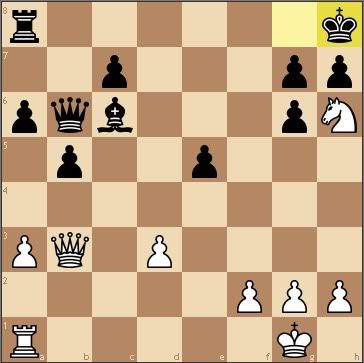
4.Qb3-g8+!! Ra8xg8 forced, because the King can't take due to our h6-Knight.

5. Nh6-f7# smothered mate
So we can see here the power of double-check. The Knight was under attack, but couldn't be taken because of the other check from the Queen. This made us able to execute a Queen sacrifice, forcing black's own pieces to do harm to their own king.
____________
|
|
ihor

 
    
Supreme Hero
Accidental Hero
|
 posted November 04, 2009 08:19 AM
posted November 04, 2009 08:19 AM |
|
|
Ahh, that was harder than previous ones. I thought about Qd1-b3+ but then get lost.
I didn't get where was attraction here?
____________
Your advertisement could be
here only for 100$ per day. 
|
|
keldorn

  
  
Promising
Known Hero
that casts green flames
|
 posted November 04, 2009 02:43 PM
posted November 04, 2009 02:43 PM |
|
|
On the last moce we forced black's Rook to g8, covering the king's only escape square.
____________
|
|
ihor

 
    
Supreme Hero
Accidental Hero
|
 posted November 04, 2009 03:35 PM
posted November 04, 2009 03:35 PM |
|
|
Aha, right, thanks.
When will be the next one?   
____________
Your advertisement could be
here only for 100$ per day. 
|
|
keldorn

  
  
Promising
Known Hero
that casts green flames
|
 posted November 04, 2009 06:24 PM
posted November 04, 2009 06:24 PM |
|
|
Right now 
Here it's black to move and win a piece. Use HCM to post your solutions please!
This game was played between me and my friend live. His last move was a serious mistake. How can black exploit the position? NOTE: This problem is just one move long, but I'd like you to give me the explanation on why you choose your move. This requires about 2-3 moves long foresight, which you can send me via HCM too. Good luck 
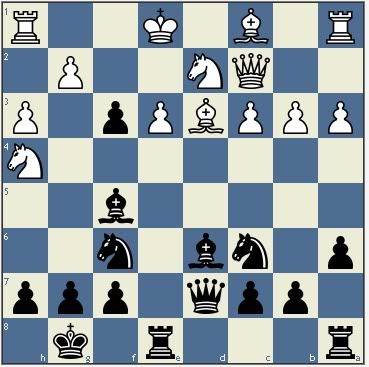
____________
|
| |
|
|





